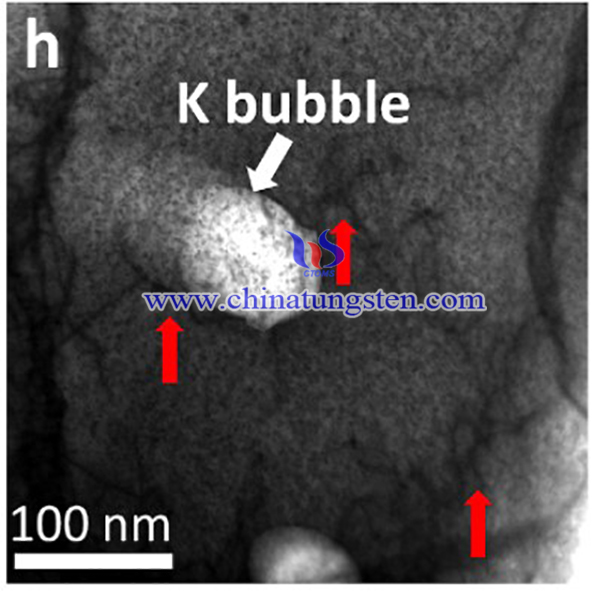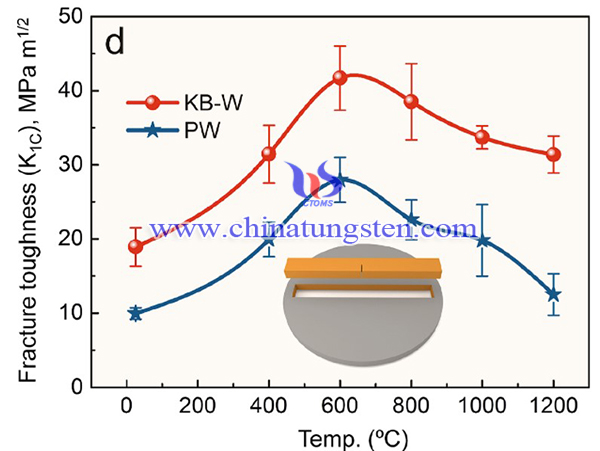Tungsten Alloys with High Thermal Shock Resistance via Ammonium Paratungstate
- Details
- Category: Tungsten Information
- Published on Tuesday, 06 April 2021 17:49
Tungsten (W) alloys has been applied in high temperature resistant materials for decades due to its amazing thermal resistance and toughness. W alloys have been applied in plasma-facing materials, solid target in spallation neutron source, electrical contacts, and fuel elements in rockets, etc. These applications have a requirement on higher mechanical properties and higher temperature stability.
Bubble strengthening, with potassium (K) bubbles as the most known dispersion phase, is particularly promising to enhance the thermal shock resistance of W alloys. In order to enhance the thermal shock resistance of tungsten alloys, we describe an industrially applicable strategy combining aluminum-silicon-potassium (AKS) doping and spark plasma sintering (SPS) to produce nanoscaled gaseous potassium bubbles (∼50 nm) inside the bulk tungsten grains, as in the tungsten wires.

The production process of tungsten alloys with high thermal-shock resistance via ammonium paratungstate as below:
For dispersion strengthening there is a popular belief that the dispersion phase should be as small as possible (to nanometer level) and be distributed in the grain interior. To realize that kind of microstructure in W-K alloys, Tungsten blue oxide (TBO) was first produced by calcinations of ammonium paratungstate (APT). The TBO particles that have a high internal porosity formed during calcinations. The doped TBO powder was then subjected to high-temperature H2 reduction, acid washing, and drying. The Al-K-Si-O compounds were formed and incorporated into the tungsten particle interior during those processes. The chemical composition of the pure tungsten powder (PW) and AKS-doped tungsten powder (KB-W) used in this study is shown in Table 1. The contents of potassium and silicon were determined with atomic adsorption spectroscopy, and the contents of other metallic impurity elements were measured by inductively coupled plasma-optic emission spectroscopy.

The AKS-doped tungsten powders were then consolidated through SPS (Labox-325, Sinterland Inc., Nagaoka, Japan; Fig. 3d). The optimization of the sintering conditions to obtain W-K materials with high density, fine grains and nanometer bubbles in the grain interior have been carried out and more details can be found elsewhere. The sample was heated from room temperature to 600 °C in 5 min. It was then brought to 1400 °C holding for 6 min and then 1750 °C holding for 2 min at a heating rate of 100 °C/min. The samples were then furnace-cooled to room temperature. To degas the AKS-doped tungsten powder, the applied compressive pressure was set to just 20 MPa at the first 6 min of the sintering process, then it was increased to 80 MPa in 3 min (corresponding to 900 °C) and hold until the samples were cooled down to room temperature.
In conclusion, Tungsten alloys with high thermal-shock resistance have been synthesized via ammonium paratungstate (APT), potassium nano-bubbles were dispersed on bulk tungsten to enhance its properties. The average grain size of KB-W is 5.74±1.52 μm and PW is 3.61±1.15 μm. The facture toughness of KB-w (19.87±2.6 MPa m1/2) is much stronger than that of PW as 9.95±0.77 MPa m1/2. KB-W alloy displays high resistance to thermal shocks. The method utilized here is amenable to large-scale samples at low cost, and has the potential to be applicable to other refractory metal systems.
- APT Manufacturer & Supplier, Chinatungsten Online: ammonium-paratungstate.com
- Tungsten News & Prices of China Tungsten Industry Association: www.ctia.com.cn
- Molybdenum News & Price: news.molybdenum.com.cn
- Tel.: 86 592 5129696; Fax: 86 592 5129797; Email: sales@chinatungsten.com



 sales@chinatungsten.com
sales@chinatungsten.com